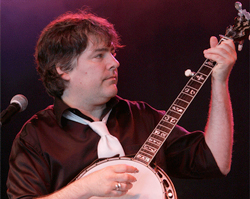by Tom Wachunas

The intense rhythms of the opening theme, announced with an exclamatory burst from brass, winds, and timpani, charged ahead with strings scampering along at breakneck speed. Through all of this Rossini-like energy, the ensemble performed with electrifying precision and radiant warmth.
Speaking of Rossini, the third work on the program was his Overture to Semiramide, from his two-act opera composed in 1823. Despite the work’s categorization as a tragic melodrama about the Queen of Babylon murdering her husband and falling in love with her son, the Overture is anything but dark. The orchestra navigated the music’s many lilting, ornamental episodes, and vivacious crescendos with the same remarkable finesse it brought to the evening’s remaining selections.
Those included Jean Sibelius’ iconic Finlandia, and Georges Enescu’s Rumanian Rhapsody No. 1. The latter work was an appropriately exuberant end to the evening, particularly in its high-velocity pyrotechnics from the wind instruments. And interestingly enough, its spirited folk melodies took me back to significant aspects of the second — and certainly most important — work on the program: the world premiere of Juno, Béla Fleck’s Second Concerto for Banjo and Orchestra. Composed in 2015-2016, the concerto is named for his 2-½ year-old son.
Fleck’s first concerto, The Impostor, composed in 2011 and performed by the CSO in 2014, told a story wherein he is the “hero” banjo player infiltrating an orchestra in an attempt to validate himself as a Classical musician, only to find he could not completely forsake his Country/Folk/Bluegrass roots. While not a narrative work as such, Juno could nonetheless be regarded as a sequel, if only because it is so successful in giving elevated credence to the banjo as a legitimate, indeed beautiful denizen of the Classical world.
Along with revealing Fleck’s heightened appreciation of the emotive colors that a full orchestra can provide, Juno also shows a studied commitment to the traditional concerto format of three movements in fast-slow-fast order. Within that structure, Fleck’s thematic developments feel less frenetic than in The Impostor, though no less an adventurous platform for his astonishing virtuosity as a soloist. This time the music, for all of its harmonic eclecticism and contrapuntal complexity, exudes newfound elegance and confidence.
The overture-like first movement introduces most of the concerto’s thematic motifs in one form or another. Initially, a fanfare-like passage for the brass mingles with strings and winds to evoke the feeling of a mystical pastorale, at times soaring with an almost cinematic flourish. Fleck’s chording and spectacular arpeggios acted as a pulse, at times like so many dissonant heartbeats, adding a haunting tension.
A similarly haunting lyricism in the slow second movement was enhanced by sensual sliding notes from the sonorous cellos and violas. Passages from clarinet and oboe evoked vaguely Asian harmonies that seemed to effortlessly morph into earthy tunes of an Appalachian nature. Indeed, the entire work is an ostinato tour de force of blended melodies, replete with complex rhythms in unexpected meters, all executed with riveting clarity and meticulous attention to aural textures. Yet never once did the music feel chaotic, even amid the boisterous swagger of the trumpets and percussion in the third movement. Another noteworthy development in Juno is Fleck’s creative generosity in letting the orchestra exercise its own remarkable virtuosity. He’s content to often be in a supportive rather than leading role.
In some ways, you could liken the difference between Fleck’s two concertos to the difference between a nervous, first-date kiss and a fully-matured relationship. Greatly inspired by Gerhardt Zimmermann’s astute reading of his first concerto, Fleck was more than eager to choose the CSO as lead commissioner for this new work (co-commissioned by the Colorado Symphony, Louisville Orchestra, and South Carolina Philharmonic). The opportunity afforded him a way, in his words, “…of going back to the well, back to the same challenges and seeing what I learned from them in the first concerto…”
“I’m really happy about this,” Fleck says of his fruitful work with the CSO, “because I love this orchestra and I love Gerhardt.” Judging from the purposeful and infectious chemistry that united composer with conductor and ensemble in this stunning performance, the feeling was mutual.
Published on ClevelandClassical.com March 23, 2016.
Click here for a printable copy of this article


